Sundials and calendars were essential tools in ancient Rome for regulating daily life. They structured everything from work schedules to religious observances, shaping how Romans experienced time.
Roman timekeeping relied heavily on natural phenomena like the sun’s movement, with sundials serving as the primary instrument for measuring daylight hours. Calendars organized the year into months and days, guiding social, political, and religious events.
In this article, you will learn about:
- The foundations of Roman time measurement, including the division of day and night
- The introduction and mechanics of sundials in Roman society
- Portable sundials and their users
- Complementary devices like water clocks
- The evolution of Roman calendars from lunar to solar systems
- How calendars structured festivals, politics, and public life
- Monumental sundials as symbols of imperial power
- The impact of timekeeping on daily routines, military schedules, and public events
Understanding these elements reveals how Romans synchronized their lives with the natural world and complex societal needs.
The Foundations of Roman Timekeeping
Roman timekeeping was deeply rooted in natural observations that shaped how the day was divided and understood. The fundamental division of the day split it into two distinct periods:
- Ante Meridiem (AM): the hours before midday.
- Post Meridiem (PM): the hours after midday.
This system allowed Romans to organize daily activities around the sun’s position, marking clear boundaries between morning and afternoon.
Seasonal Hours
Roman hours were not fixed lengths like modern hours. Instead, they were seasonal hours, meaning their duration varied according to the time of year. During summer, daylight hours stretched longer, so each hour expanded to roughly 75 minutes. In winter, shorter days meant hours contracted to about 45 minutes each. This flexible structure reflected a close relationship with natural phenomena—sunrise, sunset, and the sun’s arc across the sky.
Greek Influence
The practice of dividing daylight into twelve equal parts originated from Greek influence but was adapted by Romans to fit their environment and societal needs. Nighttime had its own divisions but was less rigidly structured since artificial light sources were limited.
Sundials and Complexity
The reliance on solar movement made sundials effective tools for measuring time outdoors. However, this system also introduced complexity because the length of an hour was never constant throughout the year. Such variations influenced when work began and ended, when public events were scheduled, and how religious rituals aligned with daylight.
In essence, Roman timekeeping mirrored nature’s rhythms rather than imposing fixed mechanical intervals. This approach created a dynamic temporal framework that connected human activity directly to the cycles of day and night.
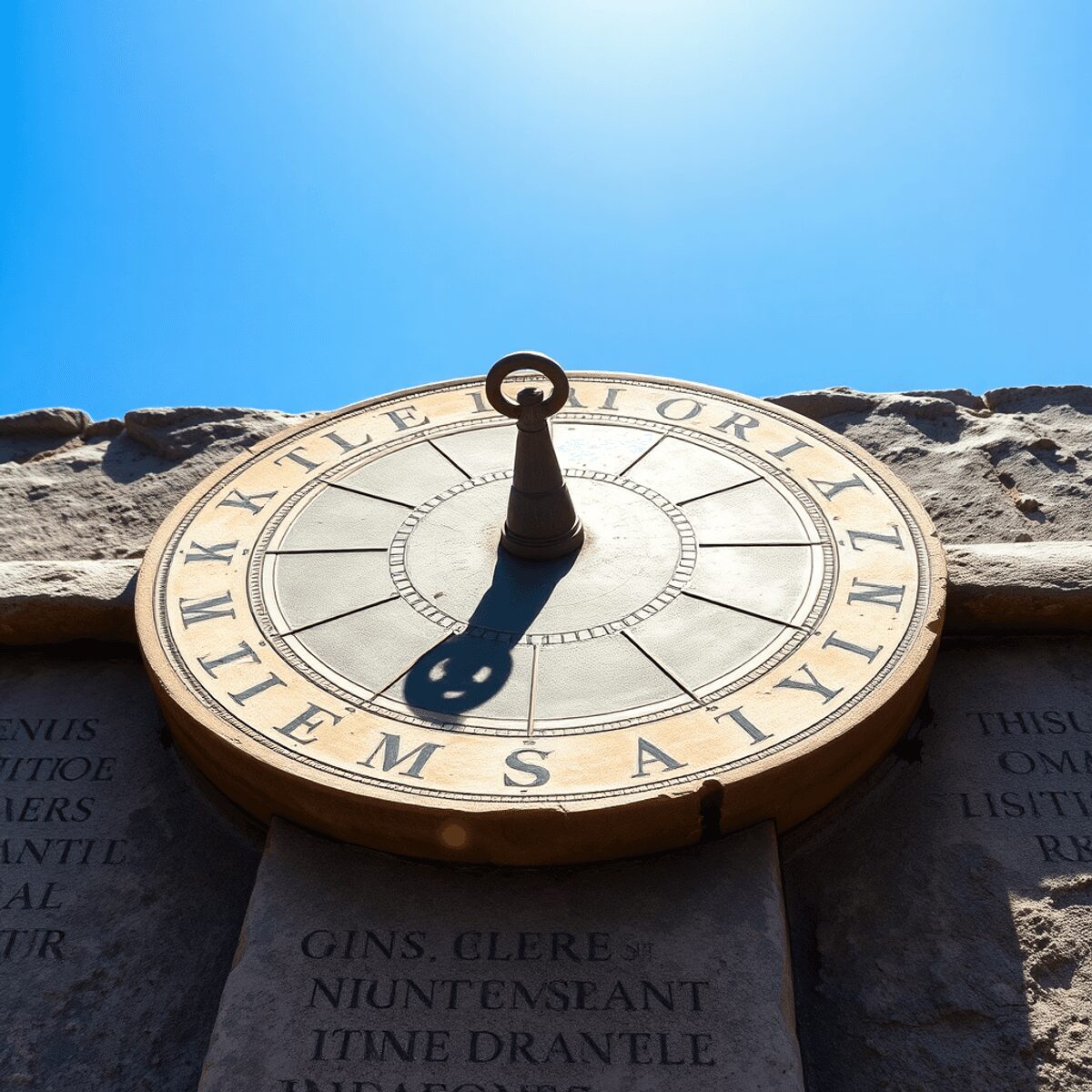
Sundials: The Primary Timekeeping Device
Sundials became the cornerstone of Roman timekeeping after their introduction to Rome by the Greeks around 293 BC. This innovation marked a significant advancement from earlier, less precise methods. Romans adopted and adapted the Greek design to suit their needs, making sundials widely used across the empire.
The core function of sundials was to divide the daylight period into 12 hours. Unlike modern fixed-length hours, these hours varied in length according to the season. At Mediterranean latitudes, where Rome is located, daylight hours could stretch to about 75 minutes during summer and shrink to approximately 45 minutes in winter. This seasonal variation allowed for an accurate representation of time based on natural light rather than a rigid clock system.
How Sundials Work
Key elements that made sundials work included:
- Gnomon: A vertical rod or triangular blade that cast a shadow onto the dial face.
- Shadow casting: As the sun moved across the sky, the shadow shifted position, indicating different times of day.
- Hour lines inscribed on the dial corresponded to specific periods when the shadow would fall on them.
The gnomon’s angle was carefully aligned with Earth’s axis, ensuring that the sundial’s readings were as precise as possible over different seasons. Sundials required direct sunlight to function, making them most effective outdoors during clear weather.
The Roman Adoption of Sundials
Romans relied heavily on this method because it linked time measurement directly to solar movement, which was familiar and observable. The Greek influence introduced a scientific approach that helped standardize daily activities such as market openings, legal proceedings, and religious observances based on solar time.
By dividing daylight into 12 variable hours through sundials—an ancient timekeeping device—Romans developed an intuitive understanding of time’s flow tied closely to nature—an approach that shaped their daily routines long before mechanical clocks emerged.
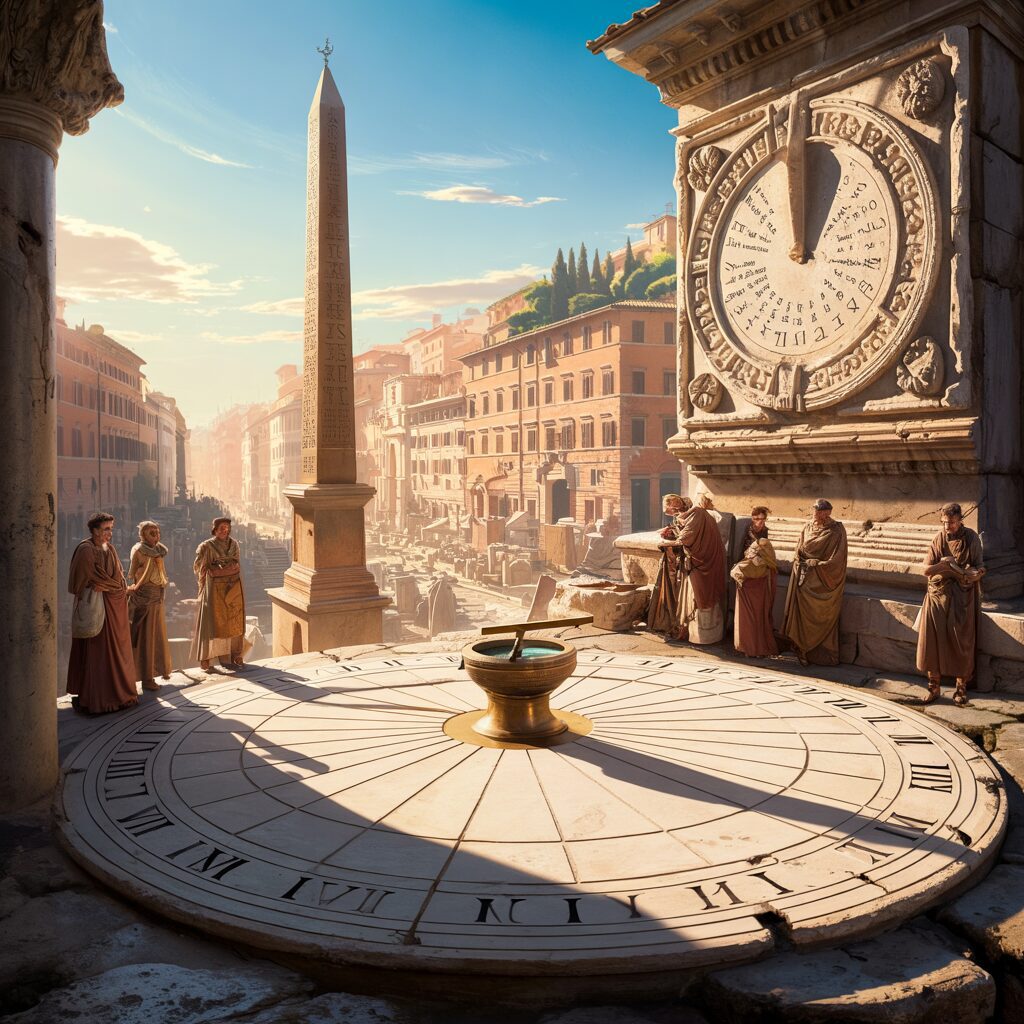
Portable Sundials and Their Users
Portable sundials in ancient Rome represented a small but fascinating part of Roman timekeeping. Unlike the large, fixed sundials found in public spaces, these devices were small, lightweight, and designed for personal use or travel. They were rare because it was difficult to make accurate yet compact instruments that could measure time based on the sun’s position.
Who Used Portable Sundials?
Typical users of portable sundials included:
- Wealthy elites who valued precision and convenience in managing their schedules.
- Travelers who required a dependable way to keep track of time away from urban centers or public sundials.
How Were Portable Sundials Designed?
These portable devices often incorporated a hinged gnomon and engraved hour lines calibrated for specific latitudes. This design allowed users to adjust their sundial depending on their location and season, maintaining reasonable accuracy despite environmental variations.
The Significance of Owning a Portable Sundial
Owning such a sundial was both practical and a status symbol. For elites, it demonstrated sophistication and command over temporal order. Travelers depended on these instruments to synchronize activities during journeys, ensuring timely arrivals at meetings or events without relying solely on natural cues like sunrise or sunset.
The Impact of Portable Sundials on Roman Society
Portable sundials contributed to the broader Roman practice of time regulation by extending access to solar time beyond fixed monuments. They reinforced the importance of personal punctuality in Roman society, supporting business, social engagements, and religious observances on the move. This mobility in timekeeping complemented stationary devices and highlighted how Romans adapted technology to fit diverse lifestyles within their empire.
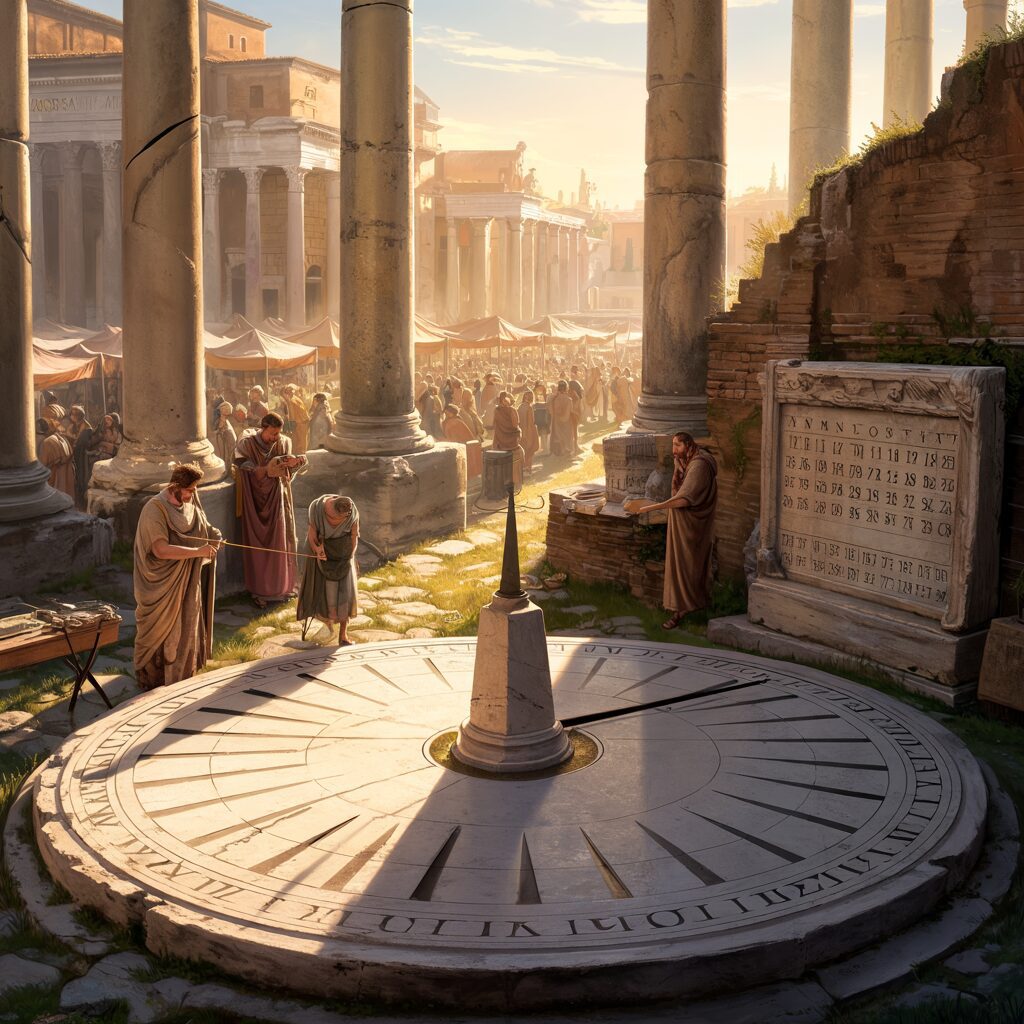
Water Clocks as Complementary Devices
Water clocks were an important technological advancement for the Romans in managing time, especially when sundials couldn’t provide accurate readings. Sundials relied solely on sunlight to cast shadows, making them ineffective in indoor spaces, on cloudy days, or during nighttime. Water clocks solved this problem by offering a reliable way to measure time regardless of weather or lighting conditions.
How Water Clocks Worked
The concept behind water clocks was simple yet brilliant. These devices measured time by controlling the flow of water either between compartments or through a carefully designed opening. As water gradually emptied from one container into another, it indicated the passing of time in measurable units. The Romans created various types of water clocks, known as clepsydrae, with different sizes and complexities based on their specific purposes.
Key Features of Roman Water Clocks
Roman water clocks had several important characteristics that made them effective:
- Consistent flow control: A narrow opening allowed water to escape at a steady rate, ensuring predictable measurement of intervals.
- Graduated markings: Inside the vessel, calibrated lines showed how much time had passed as the water level dropped.
- Adjustability: Some water clocks included mechanisms to account for temperature changes affecting the thickness and speed of flowing water.
Uses of Water Clocks
Water clocks were especially valuable in legal and political settings where precise timing was crucial—court sessions and public speeches often followed limits enforced by these devices. Military leaders also depended on them to coordinate watches during nighttime hours when sundial usage was impossible.
While not as prominent as large sundials, water clocks demonstrated Roman creativity in maintaining orderliness across different situations. They complemented solar-based timekeeping by extending the ability to regulate daily activities beyond daylight hours and environmental limitations.
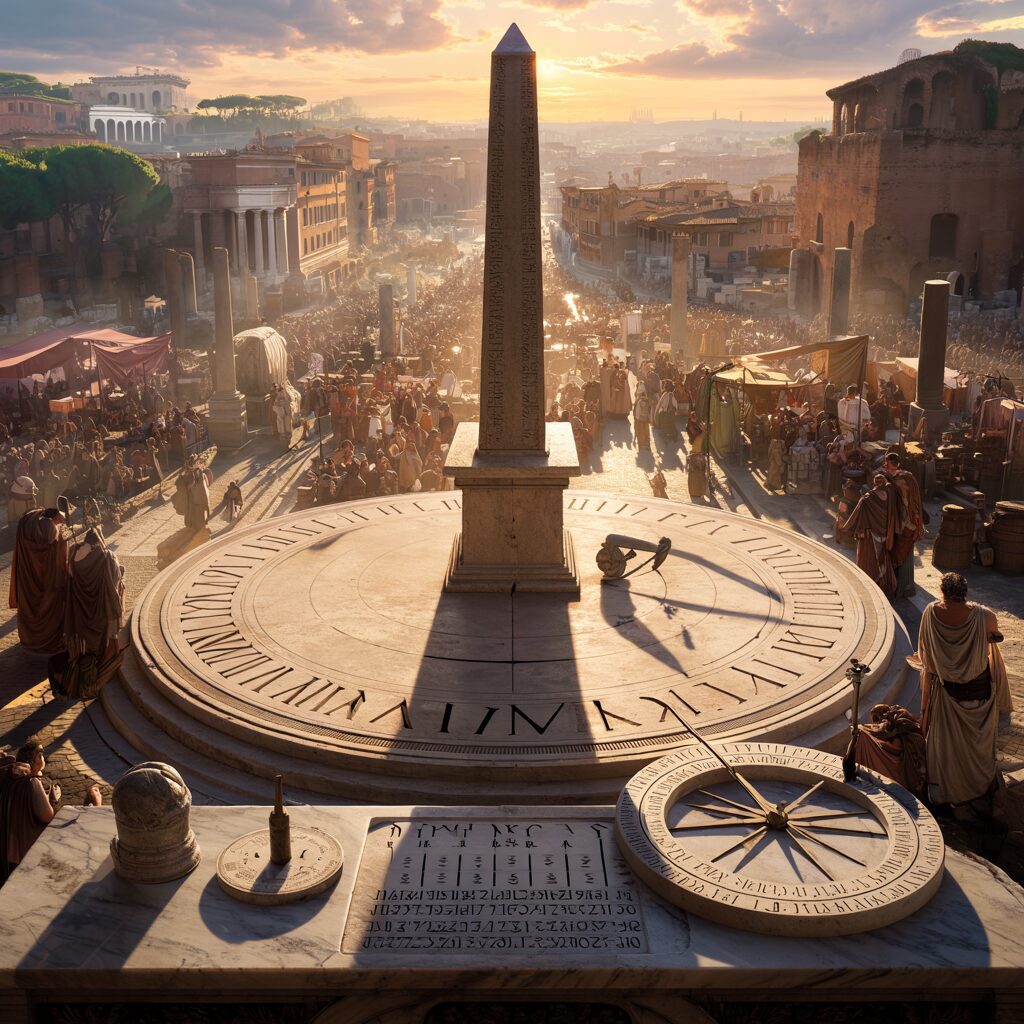
Roman Calendars and Their Evolution
The Early Roman Calendar: A Lunar System
The earliest Roman calendar was predominantly a lunar calendar consisting of ten months. This system aligned months with the moon’s phases, but it lacked synchronization with the solar year, causing significant drift over time. The months were:
- Martius (March)
- Aprilis (April)
- Maius (May)
- Iunius (June)
- Quintilis (later Iulius, July)
- Sextilis (later Augustus, August)
- September
- October
- November
- December
These months totaled approximately 304 days, leaving an unstructured winter period that was not assigned to any month. This lunar structure created confusion for agricultural planning and religious observances tied to solar seasons.
The Need for Reform: Enter Julius Caesar
The need for a more reliable calendar grew critical as Rome expanded in size and complexity. The answer came with the Julian calendar, introduced by Julius Caesar in 45 BCE after consulting astronomers like Sosigenes of Alexandria.
This reform shifted Rome from a lunar to a solar-based calendar system, closely modeling the Egyptian solar year of 365.25 days.
Key Features of the Julian Calendar
Key features of the Julian calendar included:
- Twelve months totaling 365 days annually.
- A regular pattern of month lengths: some with 31 days, others with 30 or 28.
- Insertion of a leap year every four years to compensate for the extra quarter day per year.
The introduction of leap years was essential to correct the discrepancy between the actual solar year length and the standard calendar year. Without this adjustment, seasons would gradually shift, disrupting agriculture and festivals.
Challenges in Implementation
Despite its improvements, early implementation of the Julian calendar faced challenges. Leap years were initially added every three years due to misinterpretation of instructions, causing further drift until corrected by Emperor Augustus.
Impact on Roman Society
This evolution from a fragmented lunar system to a structured solar calendar allowed Romans to organize their civic and religious life with greater precision. It standardized dates for public festivals, political events, and agricultural activities—further entwining timekeeping with social order.
Legacy of the Julian Calendar
The Julian calendar’s influence extends beyond Roman times; it laid groundwork for many modern calendars still in use today, demonstrating its lasting legacy in regulating human activity through consistent temporal measurement.
The Importance of Calendars in Organizing Society
Roman calendars were not just tools for keeping track of days; they played a crucial role in shaping the rhythm of religious festivals, social events, and political activities. These calendars ensured that community life followed a shared schedule deeply rooted in Roman culture.
1. Religious Observances and Festivals
The Roman calendar marked sacred dates for numerous religious festivals, which were vital to maintaining favor with the gods and social cohesion. Each festival had its fixed day or days in the year, such as the Saturnalia in December or the Lupercalia in February. These observances required precise timing so that rituals could be performed correctly, often involving sacrifices, public prayers, or processions. The calendar’s role was critical here—it guaranteed these events took place punctually, reinforcing religious traditions and collective identity.
2. Coordination of Social Activities and Public Spectacles
Public entertainment such as gladiatorial games, theatrical performances, and chariot races followed a predictable schedule dictated by the calendar. Specific dates were reserved for these spectacles, allowing citizens to plan attendance. The timing of these events often coincided with religious festivals or political anniversaries, creating a layered social experience. This calendrical coordination helped maintain a vibrant civic life where leisure and community engagement were woven into the yearly cycle.
3. Political Significance and Social Order
Elections, assemblies, and official ceremonies depended heavily on a shared temporal framework established by the calendar. For example:
- Elections for magistrates were scheduled on fixed dates to ensure orderly transitions of power.
- Assemblies convened regularly according to calendrical cycles to discuss laws or public matters.
- Official holidays provided predictable breaks from labor and opportunities for political propaganda or imperial messaging.
The calendar functioned as a political tool that reinforced authority by imposing structure on public life. It also helped regulate daily routines by embedding political participation within an agreed schedule.
Roman timekeeping—through calendars—thus operated at multiple societal levels simultaneously: guiding religious devotion, enabling social interaction via public events, and sustaining political stability through regulated governance cycles. This interconnectedness made calendars indispensable instruments for organizing Roman society’s complex fabric of daily activities.
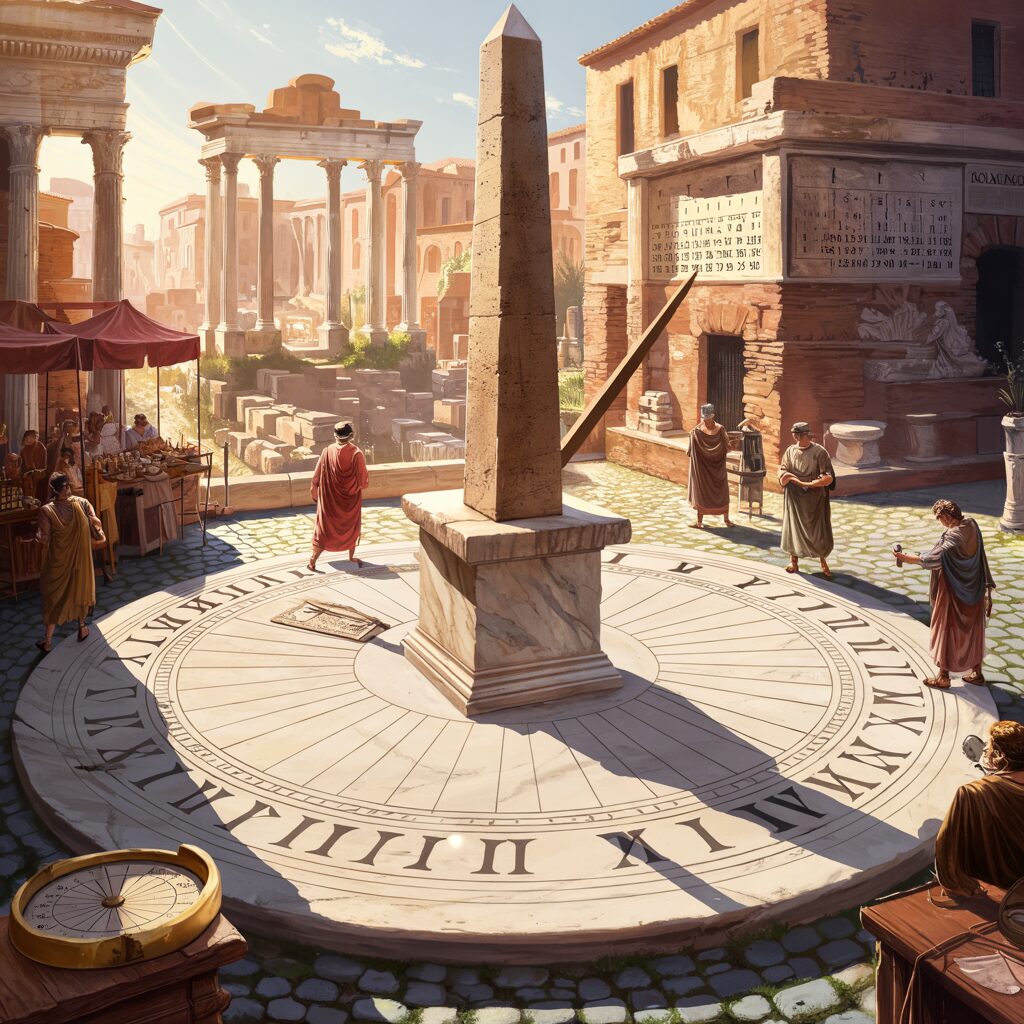
Monumental Sundials as Public Timekeepers
Monumental sundials like the Horologium Augusti were important structures in ancient Rome that combined technology, politics, and public life. These large-scale sundials served a purpose beyond just telling time; they represented the power of the emperor and conveyed messages of stability and order to the people.
1. Horologium Augusti: The Massive Sundial of Augustus
Erected by Emperor Augustus in the Campus Martius, this massive sundial featured an obelisk imported from Egypt serving as its gnomon. Its shadow moved across a carefully designed pavement, indicating the hour of the day with remarkable precision. The monument’s scale made it visible from afar, reinforcing the idea that time—and by extension, society—was under imperial control.
2. Functionality and Symbolism of Sundials
Monumental sundials served multiple purposes in ancient Rome:
- Acted as public clocks accessible to all citizens, regulating daily activities and events.
- Demonstrated Roman engineering prowess and mastery over natural phenomena.
- Served as a visual metaphor for Augustus’ role as a bringer of order to Rome’s chaotic past.
3. Political Symbolism Behind Timekeeping
The significance of these sundials extended beyond their practical use:
- Linked the emperor’s image to cosmic order and divine favor.
- Presented timekeeping as a state function, centralizing power through control of temporal measurement.
- Highlighted Rome’s connection to Egypt after conquest, symbolizing imperial expansion.
Monumental sundials reinforced how deeply intertwined timekeeping was with governance and social cohesion. Their presence in prominent public spaces reminded Romans that every moment was accounted for within an empire ruled by law and precision. This physical manifestation of time also supported civic pride, tying daily life to the grandeur of Roman civilization itself.
Regulation of Daily Routines Through Timekeeping Devices
Timekeeping devices in ancient Rome played a crucial role in structuring daily life by aligning human activities with the natural cycle of the sun. This synchronization helped Romans optimize their work schedules, religious observances, and military operations.
1. Work Schedules Aligned with Solar Time
The division of daylight into twelve hours, tracked by sundials, allowed workers to organize their labor according to the sun’s position. Daylight hours expanded in summer and contracted in winter, so the length of an hour was not fixed but adapted seasonally. This meant that work periods were flexible yet consistent with natural light availability. Farmers, artisans, and merchants used these time cues to begin and end tasks efficiently, minimizing wasted daylight or working in darkness.
2. Canonical Hours for Religious Observances
Religious rituals were scheduled based on Roman clock times derived from sundials and water clocks. The concept of canonical hours—specific times during the day set aside for prayer and worship—was deeply embedded in Roman religious practice. Worshippers gathered at temples or household shrines at these appointed intervals to perform sacred acts such as sacrifices or prayers. These fixed moments maintained spiritual discipline within the community and highlighted the importance of temporal order alongside religious devotion.
3. Military Watches and Shift Coordination
Military units relied heavily on timekeeping devices to organize watches or shifts among soldiers. Precise timing was essential for maintaining security, especially during nighttime or periods of heightened alertness. Water clocks were particularly useful indoors or during night watches when sundials could not function. Commanders used these devices to ensure orderly rotations of duty posts, preventing lapses in vigilance and promoting operational efficiency across forts and camps.
The integration of sundials and water clocks into daily routines reinforced a shared understanding of time that governed both private life and public duty. This temporal framework supported a society where individual actions aligned with communal rhythms dictated by celestial cycles and practical necessities.
Market Days, Public Spectacles Timing, and the Roman Conceptualization of Time Cycles
Roman calendars played a crucial role in organizing market days that stimulated economic activity across towns and cities in the empire. These recurring market days were not randomly scheduled but carefully integrated into the calendar system, ensuring predictable intervals for trade and commerce. Merchants, farmers, and consumers relied on this regularity to plan their visits, sell goods, and procure necessities. The synchronization of market days with the broader calendrical cycle helped maintain social cohesion by linking economic rhythms with communal timekeeping.
Public spectacles such as chariot races and gladiatorial games depended heavily on precise timing aligned with calendar dates. These events were major social occasions attracting both local citizens and visitors from distant regions. Authorities scheduled spectacles to coincide with significant festivals or holidays marked on the calendar, maximizing attendance and public engagement. The careful orchestration of these entertainments demonstrated how Roman timekeeping was not merely about measuring hours but about coordinating collective experiences tied to specific dates.
Romans did not view time as a string of fixed hours like modern clocks suggest. Instead, their concept was deeply cyclical, rooted in natural phenomena that repeated predictably:
- Sunrise and sunset cycles defined the transition between day and night.
- Lunar phases guided monthly observances and religious rituals.
- Seasonal changes influenced agricultural activities and festival timing throughout the year.
This cyclical understanding meant that time was experienced as patterns within nature rather than uniform increments independent of environment. Hours varied in length across seasons, reflecting the changing duration of daylight—a practice embedded in sundial usage and calendar adjustments.
“Time itself is woven into the fabric of nature’s repeating rhythms,” encapsulates the Roman approach. It connected human activities to celestial movements and earthly cycles instead of abstract numerical divisions.
The integration of market days, public spectacles, and cyclical time perception illustrates how Roman Timekeeping: How Sundials and Calendars Regulated Daily Routines extended beyond mere measurement. It provided a framework for harmonizing social life with cosmic order, ensuring that economic transactions, entertainment, and religious ceremonies all unfolded within a shared temporal landscape shaped by natural cycles.
Conclusion
The legacy of Roman timekeeping remains deeply embedded in the way we organize and understand time today. Romans pioneered methods that transformed natural phenomena into practical tools like sundials and calendars, which regulated daily routines with remarkable precision for their era. Their innovations laid the groundwork for the fixed-length hours and standardized minutes that define modern clocks.
Key influences include:
- The division of the day into ante meridiem (AM) and post meridiem (PM) periods.
- Adaptation to seasonal changes by varying hour lengths, a concept that evolved into consistent time measurements.
- Integration of calendrical cycles to structure social, religious, and political life.
Roman Timekeeping: How Sundials and Calendars Regulated Daily Routines reveals how these ancient systems went beyond mere measurement—they shaped society’s rhythm. This influence extends beyond history books, impacting contemporary perceptions of time as a structured, shared experience that governs work, worship, entertainment, and governance.
Exploring Roman innovations offers insight not only into ancient technology but also into foundational ideas about time that continue to resonate. Next time you glance at a clock or calendar, consider the ingenuity behind these tools—rooted in the sunlit forums and bustling streets of ancient Rome.
Dive deeper into the fascinating world of Ancient Rome beyond iconic landmarks like the Colosseum or Pantheon. Discover how everyday lives were intertwined with celestial movements and imperial order through their mastery of time itself.

